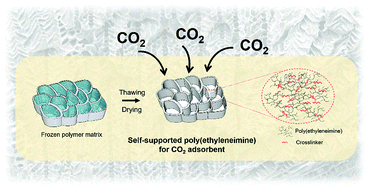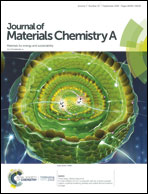Self-supported branched poly(ethyleneimine) materials for CO2 adsorption from simulated flue gas†
Abstract
Self-supported, branched poly(ethyleneimine) materials for CO2 adsorption are prepared via an ice templating method. Crosslinking with poly(ethylene glycol) diglycidyl ether during the ice formation enables construction of a highly porous structure without utilization of freeze-drying. Depending on the amount of the crosslinker in the adsorbent, the sorbent family's CO2 adsorption capacities and kinetics can be tuned, with sorbent materials offering optimum temperatures in the range of 25–75 °C. Different crosslinking temperatures used during preparation of adsorbents affect the physical structures of the adsorbents, which directly impact the sorption capacities and kinetics. An adsorbent prepared using liquid nitrogen is effective at 25 °C and offers an extremely high amine efficiency of 0.32 and capacity of 2.81 mol CO2 per kg sorbent, reaching 80% of its maximum capacity in only 18 min (10% CO2 at 1 bar total pressure). This material's uptake rose to 5.5 mol CO2 per kg sorbent when the gas was at 65% relative humidity. The prepared adsorbent also presents stable recyclability over 50 dry adsorption–desorption cycles with only a minor loss of CO2 capacity (4%). The CO2 capacity over increasing cycles is estimated to converge at 95% of its initial capacity according to a fitted exponential decay equation, making this material a promising new material for post-combustion CO2 capture.



 Please wait while we load your content...
Please wait while we load your content...
